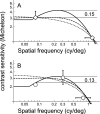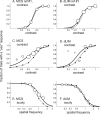Neonatal Contrast Sensitivity and Visual Acuity: Basic Psychophysics
- PMID: 29946492
- PMCID: PMC6016435
- DOI: 10.1167/tvst.7.3.18
Neonatal Contrast Sensitivity and Visual Acuity: Basic Psychophysics
Abstract
Purpose: This research was prospectively designed to determine whether a 0.083 cycles per degree (cy/deg) (20/7200) square-wave stimulus is a good choice for clinical measurement of newborn infants' contrast sensitivity and whether the contrast sensitivity function (CSF) of the newborn infant is band-pass. The results were retrospectively analyzed to determine whether the method of constant stimuli (MCS) and the descending method of limits (dLIM) yielded similar results.
Methods: In across-subjects experimental designs, a pilot experiment used MCS (N = 47 visual acuity; N = 38 contrast sensitivity at 0.083 cy/deg), and a main experiment used dLIM (N = 22 visual acuity; N = 22 contrast sensitivity at 0.083 cy/deg; N = 21 at 0.301 cy/deg) to measure visual function in healthy newborn infants. Three candidate CSFs estimated maximum neonatal contrast sensitivity. MCS and dLIM psychometric functions were compared while taking the stimulus presentation protocols into account.
Results: The band-pass CSF fit the data best, with a peak sensitivity near 0.31 at 0.22 cy/deg. However, the 0.083 cy/deg square-wave stimulus underestimated the best performance of newborn infants by less than 0.15 log10 units. MCS and dLIM data agreed well when the stimulus presentation contingencies were taken into account.
Conclusions: Newborn contrast sensitivity is well measured using a 0.083 cy/deg square-wave target, regardless of which CSF shape is correct. MCS and dLIM yield wholly comparable results, with no evidence to suggest effects of other factors such as infant inattention or examiner impatience.
Translational relevance: These measurements open the way for clinical behavioral measurement of infant visual acuity and contrast sensitivity in the neonatal period.
Keywords: acuity; contrast sensitivity; method of constant stimuli; method of limits; newborn infant.
Figures





References
-
- Brown AM, Yamamoto M. . Visual acuity in newborn and preterm infants measured with grating acuity cards. Am J Ophthalmol. 1986; 102: 245– 253. - PubMed
-
- McDonald M, Dobson V, Sebris SL, Daich L, Varner D, Teller DY. . The acuity card procedure: a rapid test of infant acuity. Invest Ophthalmol Vis Sci. 1985; 26: 1158– 1162. - PubMed
Grants and funding
LinkOut - more resources
Full Text Sources
Other Literature Sources

